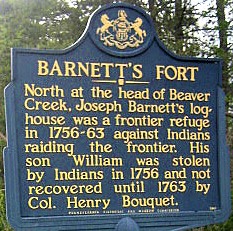Welcome to July! I hope everyone had a safe and enjoyable holiday weekend.
We're going to head back to Dauphin County today, thanks to some photos that were sent to me by John Robinson, a retired employee of the PHMC. Most of what John emails me comes from Beaver County, but this time he also sent a picture which actually connects to a previous post in this blog. My longtime readers may remember when I wrote about the Blue Mountain Forts two years ago, and the post concluded with the observation that I hadn't learned as much about them as I would have liked. It also mentioned the names of five confirmed forts which were part of this chain; there's apparently a sixth but I couldn't find a source which identified it for sure (although it may have been Fort Lebanon). All of those forts have historical markers of their own, and today we'll be taking a look at one of them.
 |
| The marker is situated at the intersection of PA Route 39 and Pikestown Road. Image courtesy of John Robinson. |
One of these was Barnett's Fort, which - like some of the others covered in past blog post - was someone's house. Built in the mid-1750s, it was a log home situated near the head of Beaver Creek; the forts were always located close to a water supply. Of Joseph Barnett himself, who gave his name to the building, not much seems to be known. In fact, searching for the name brings up a number of wrong answers, including a London man suspected of being the true identity of Jack the Ripper. (That was definitely not our Joseph Barnett, since he lived about a century before the Ripper and on the wrong side of the ocean.)
The Dauphin County Historical Society has an article in their archives, published in 1902 in the Reformed Church Record, which they describe as "entertaining if not entirely accurate." According to the article, the log block house was built by a number of area families to give them protection while they worked their farms. One day in 1756, Barnett and a neighbor (identified in the article only as "Mr. Mackey") were working in the fields when they received word that their families had been attacked and murdered by Natives. They headed home and were ambushed; Barnett survived but Mackey did not. Barnett's family was actually perfectly safe with the exception of his son William, who was about eight years old. He and one of Mackey's sons had been captured by the Natives and taken west, much like what would happen to the sons of Jacob Hochstetler a year later.
William and the Mackey boy would not be reunited with their families for several years. The details of exactly how William was recovered aren't clearly presented, but the marker gives the credit to Col. Henry Bouquet. Bouquet led forces in the Battle of Bushy Run, the battlefield of which is now a historical park, and through the effort was able to come to the aid of the besieged Fort Pitt. There, he was able to negotiate and arrange for dozens of captured settlers to be released; William Barnett's name does not seem to be in the list. However, if Daniel Miller's article is correct on this point, William had been adopted by a Native American couple whose own son had died, so his name may have been recorded incorrectly when he was rescued in 1763. He was eventually returned to his father. The Mackey boy, whose first name is unknown, was (according to Miller) sent to England for some reason, where he joined the British military and returned to Pennsylvania during the American Revolution; after being reunited with his mother, he abandoned his post and returned to his family. Again, it's hard to say exactly how much accuracy is being given here.
As for the fort itself, it ceased to serve as a fort in 1763 with the signing of the Treaty of Paris. It was still standing as recently as 1900, when a photograph was taken (there's a link below where you can see it), although the photo seems to imply that it had long been abandoned. It has since been demolished; some websites suggest that the foundation can still be seen if you go exploring in the trees, but I don't know if that's true or not. If anyone finds out an answer for sure, leave me a comment, because I'll admit I'm curious!
Sources and Further Reading:
Barnett's Fort at the Dauphin County Historical Society - includes a photo of the fort circa 1900
Commonwealth of Pennsylvania. Report of the Commission to Locate the Site of the Frontier Forts of Pennsylvania. Clarence M. Busch, State Printer of Pennsylvania, Harrisburg, 1896.
Author unknown. Indian Captives Released by Colonel Bouquet. From the archives of the French and Indian War Foundation, 2016.
Except where indicated, all writing and photography on this blog is the intellectual property of Laura Klotz. This blog is written with permission of the Pennsylvania Historical and Museum Commission. I am not employed by the PHMC. All rights reserved.

No comments:
Post a Comment
I would love to hear from you!